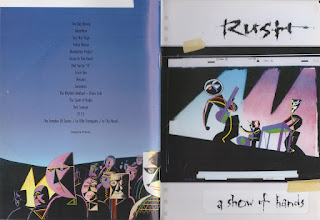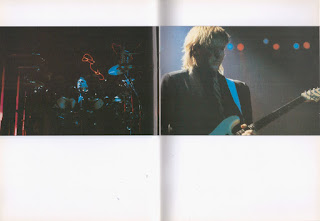( ) is the third full-length album from Icelandic post-rock band Sigur Rós, first released in October 2002. It comprises eight untitled tracks, divided into two parts: the first four tracks are lighter and more optimistic, while the latter four are bleaker and more melancholic. The two halves are divided by a 36-second silence, and the album opens and closes with a click of distortion. Lead singer Jón Þór Birgisson ("Jónsi") sang the album's lyrics entirely in "Hopelandic", a made-up language consisting of gibberish words. ( ) reached No. 51 on the Billboard 200 and received acclaim from music critics, although some reviewers found the album weaker than the band's previous album Ágætis byrjun.
This is the first album to feature new drummer Orri Páll Dýrason who joined the band in 1999, replacing their previous drummer Ágúst Ævar Gunnarsson.
The album's title consists of two opposing parentheses, representing either the album's two halves, or the idea that the album has no title, leaving the listener free to determine it. Members of the band have referred to ( ) as Svigaplatan, which translates to "The Bracket Album". In the credits of the film Heima, it is referred to as The Untitled Album. The outside packaging of ( ) consists of a plastic protective sleeve with two parentheses cut out, revealing the image printed on the CD case underneath. There are four versions of this cover art, which consist of modified photographs of nature around the band's Mosfellsbær studio, sold in four parts of the world: Europe, the United States, Australia, and Japan. In Iceland, all four cover designs are sold. The back of the packaging shows an image of a sleepwalking boy, adapted from a photograph by John Yang. In 2011, Yang's daughter, Naomi Yang, of the band Galaxie 500, said that the band used the image without permission or payment to her father. There are no liner notes or production credits included, although packaged with the album is a booklet of twelve blank pages, on which listeners are invited to write or draw their own interpretations of the album's music. A limited edition version of ( ) released in Spain includes a 94-page book of contemporary art.
( ) was co-produced and engineered by Ken Thomas, who also worked with the band on their previous album, Ágætis byrjun. This is the first album Sigur Rós recorded at their studio based in Álafoss, Mosfellsbær, a small rural town outside Reykjavík, Iceland. The band refers to the studio as "Sundlaugin", or "The Pool". ( ) includes the work of the string quartet Amiina. ( ) was given more production and recording time than Ágætis byrjun, although lead singer Jónsi considers the ( ) album "less polished" than its predecessor. He characterized the record as being "much more bare and alive and there are far fewer little slick things and much less sweet stuff." The strings of Ágætis byrjun were recorded in just two days, while two weeks were given for their recording on ( ). In addition, the former was performed by the Iceland Symphony Orchestra, while the latter was done by Amiina. Because of this, the string parts required less preparation prior to recording. The band "just let them 'jam' in the studio until everybody was happy", according to Jónsi.
( ) consists of eight tracks divided in half by thirty-six seconds of silence which, in concept, replicates the separation of two sides of a gramophone record. The first half of the album is "light and optimistic" musically, with a heavier emphasis on the use of keyboards than guitar, and the sampling of Jónsi's voice. The second half is more melancholic, playing with the emotions of the listener, as described by Jónsi. None of the tracks on ( ) have titles; band guitarist and keyboardist Kjartan Sveinsson said of this choice, "we didn't want to put titles on the record just because there are supposed to be titles on the record." The songs are listed as "Untitled #1", "Untitled #2", etc., although each track has an unofficial name used by the band.
Jónsi sang the lyrics of ( ) entirely in "Vonlenska" ("Hopelandic"), a made-up "language" which consists of meaningless words and syllables. Jónsi uses Hopelandic in place of songs which do not yet have lyrics, although some tracks on Sigur Rós albums Von and Takk... are only sung in the language. Its names in English and Icelandic are derived from "Von" ("Hope" in English), the ninth track on the album Von, which is the first instance in which Hopelandic is used in the band's music. The Hopelandic of ( ) consists of one eleven-syllable phrase, "You xylo. You xylo no fi lo. You so.", various permutations and subsequent variations thereof are sung over the course of the album. ( ) is made up of material that Sigur Rós had been playing live for over two years. For this reason, the band did not want to give the songs actual lyrics. Drummer Orri Páll Dýrason said of this, "[the songs] were fully formed and it would have been strange to suddenly insert lyrics into these finished products."
Track listing
All tracks are officially untitled, although each has an alternative name by which the band refers to it.
All tracks are written by Sigur Rós.
- Untitled ("Vaka") Vaka is the name of Orri's daughter 6:38
- Untitled ("Fyrsta") First 7:33
- Untitled ("Samskeyti") Seam, or Joint 6:33
- Untitled ("Njósnavélin") Literally, "The Spy Machine"; also known as "The Nothing Song"[42] 7:33
- Untitled ("Álafoss") Álafoss is the location of the band's studio 9:57
- Untitled ("E-Bow") Georg Hólm uses an E-bow on his bass in this song 8:48
- Untitled ("Dauðalagið") Death Song 13:00
- Untitled ("Popplagið") Pop Song 11:44
Sigur Rós – production
Ken Thomas – production, engineering, mixing
Marco Migliari – engineering
Mandy Parnell – mastering


































































